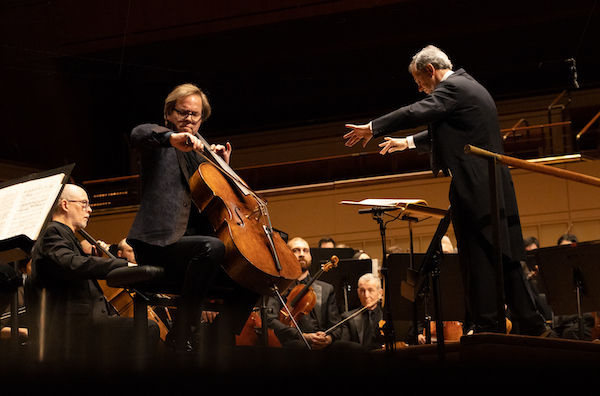Luisi, Vogler pair with Dallas Symphony for a dashing “Don Quixote”

The Dallas Symphony Orchestra is on a roll, sounding primed and ready from day one of the new season that began in September and delivering great performances week after week. The run continued on Thursday at the Meyerson Symphony Center with a thrilling evening of Strauss and Tchaikovsky at their most heroic, scenic and luminously sentimental.
Music Director Fabio Luisi, joined by cellist Jan Vogler, led the DSO in an exhilarating interpretation of Richard Strauss’ Don Quixote, and the brilliance with which the orchestra utilized color and texture to convey specific characters and themes was remarkable.
Even before he published his Don Quixote in 1897, Strauss had established his powers of description as a composer, employing a vividness and flexibility in his musical choices that both shocked and delighted listeners. Quixote — taken from the Miguel de Cervantes novel (think of it as the original buddy movie) — was the peak of his instrumental storytelling and scene-setting, and one of the greatest programmatic works by anyone. The DSO performed it masterfully.
Vogler, representing the gallantly naïve Don, offered a nimble and affectionate portrait in strings, ably drawing out the characteristic humor and whimsy of his subject. Smart double stops and tender legato phrasing defined Vogler’s virtuosic versatility and range.
DSO musicians also provided convincing interpretations of the novel’s central characters and themes. Lumbering viola solos embodied the stoutly, devoted Sancho, Quixote’s more pragmatic sidekick and companion. Winds and brass captured the emblematic elements of setting — cellos playing col legno on an eerie drone to represent the creaking of the iconic windmills, stuttering muted brass as the bleating of a herd of sheep, and timpani sounding the thud of the wayward knight falling to the ground.
Luisi’s and Vogler’s evident familiarity with the material and each other proved an asset here, as their light-hearted exchanges yielded a jovial, idyllic presentation of this popular literary material.
The second half of the program featured Tchaikovsky’s equally dramatic Fifth Symphony. Premiering in 1888, there is no mention of a programmatic core, although his Fourth and Sixth symphonies are known to have narrative sources. This work, marked by a striking theme that reappears throughout all four movements, likewise suggests a persistent plotline.
Luisi and the DSO opened with a pensive and suitably hollowed-out air of foreboding in the symphony’s central motif. Color, which seemed to be the overarching theme of this Strauss-Tchaikovsky pairing, was markedly distinct here — dark in the slow-moving intro before building up to a bright and fiery climax.
The second movement saw a lovely collaboration of solo horn and low strings on the movement’s lyrical core, with a lingering sense of contemplation that carried through to the charming waltz of the third movement. Here, again, Luisi successfully cultivated a balance of color and texture. Additionally, swift tempo changes and artful dynamic swells captured the theatrical scope of Tchaikovsky’s score.
The triumphant final movement reintroduced the central theme, now handled by adept strings. Rolling timpani provided momentum and drama to great effect as joyous winds and trumpeting fanfares presented what was once a melancholy motif, now rendered exuberant and bright.
The program will be repeated 3 p.m. Sunday, Oct. 2. dallassymphony.org


